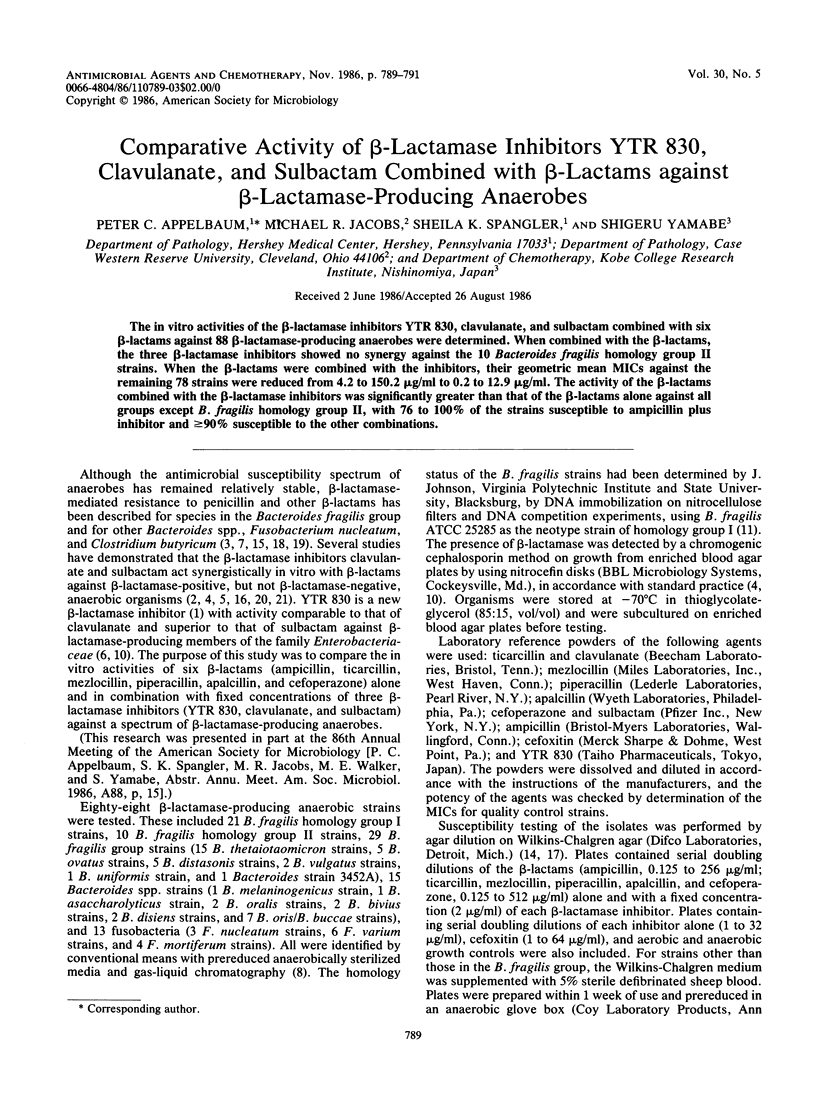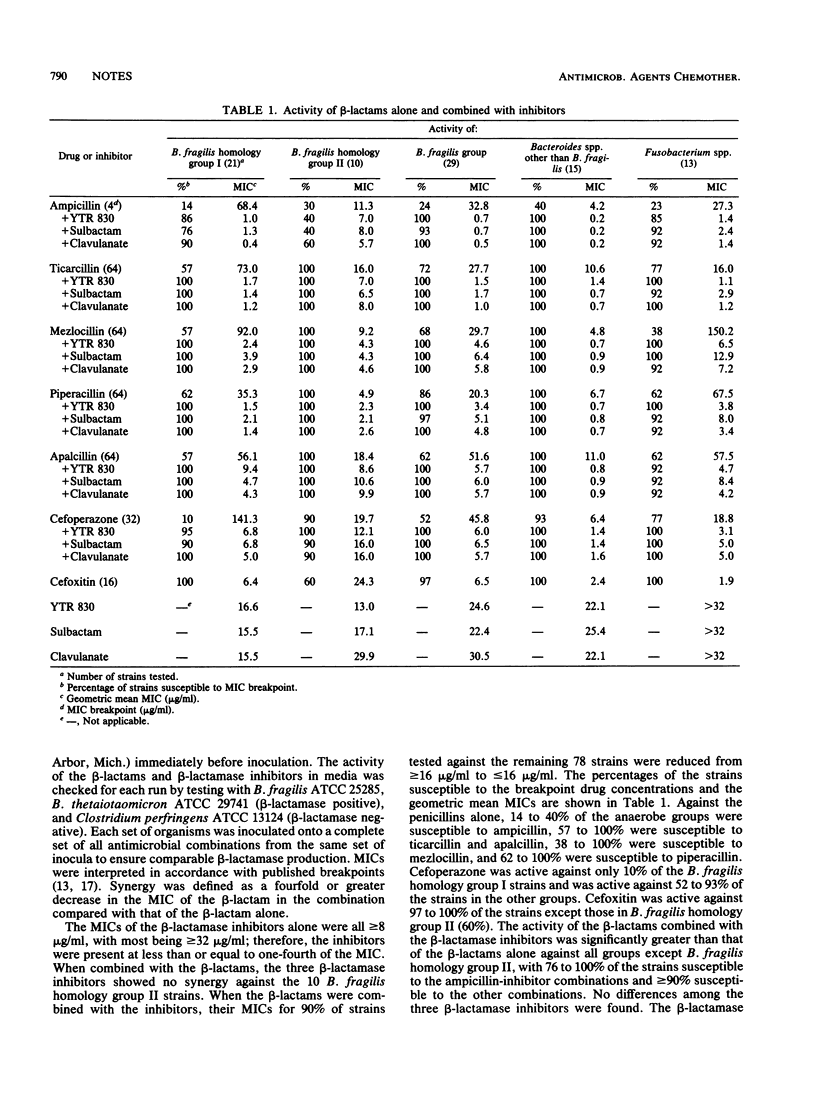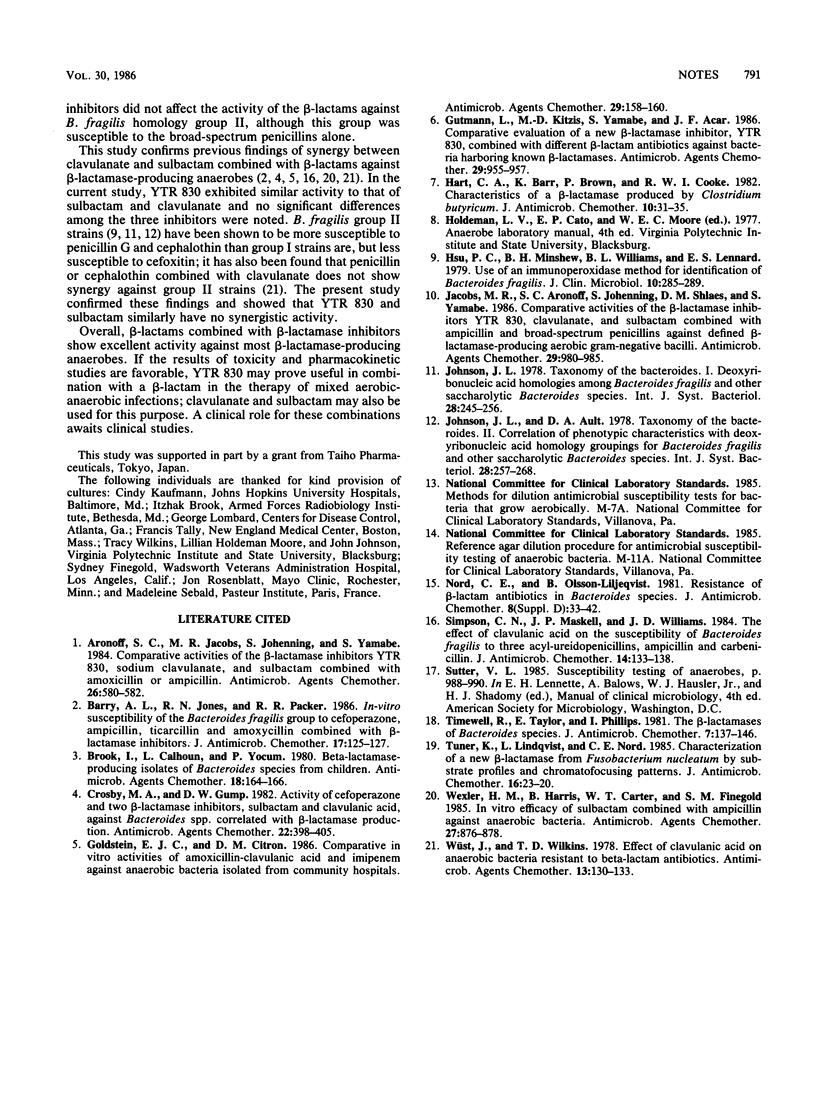Abstract
The in vitro activities of the beta-lactamase inhibitors YTR 830, clavulanate, and sulbactam combined with six beta-lactams against 88 beta-lactamase-producing anaerobes were determined. When combined with the beta-lactams, the three beta-lactamase inhibitors showed no synergy against the 10 Bacteroides fragilis homology group II strains. When the beta-lactams were combined with the inhibitors, their geometric mean MICs against the remaining 78 strains were reduced from 4.2 to 150.2 micrograms/ml to 0.2 to 12.9 micrograms/ml. The activity of the beta-lactams combined with the beta-lactamase inhibitors was significantly greater than that of the beta-lactams alone against all groups except B. fragilis homology group II, with 76 to 100% of the strains susceptible to ampicillin plus inhibitor and greater than or equal to 90% susceptible to the other combinations.
Full text
PDF


Selected References
These references are in PubMed. This may not be the complete list of references from this article.
- Aronoff S. C., Jacobs M. R., Johenning S., Yamabe S. Comparative activities of the beta-lactamase inhibitors YTR 830, sodium clavulanate, and sulbactam combined with amoxicillin or ampicillin. Antimicrob Agents Chemother. 1984 Oct;26(4):580–582. doi: 10.1128/aac.26.4.580. [DOI] [PMC free article] [PubMed] [Google Scholar]
- Barry A. L., Jones R. N., Packer R. R. In-vitro susceptibility of the Bacteroides fragilis group to cefoperazone, ampicillin, ticarcillin and amoxycillin combined with beta-lactamase inhibitors. J Antimicrob Chemother. 1986 Jan;17(1):125–127. doi: 10.1093/jac/17.1.125. [DOI] [PubMed] [Google Scholar]
- Brook I., Calhoun L., Yocum P. Beta-lactamase-producing isolates of Bacteroides species from children. Antimicrob Agents Chemother. 1980 Jul;18(1):164–166. doi: 10.1128/aac.18.1.164. [DOI] [PMC free article] [PubMed] [Google Scholar]
- Crosby M. A., Gump D. W. Activity of cefoperazone and two beta-lactamase inhibitors, sulbactam and clavulanic acid, against Bacteroides spp. correlated with beta-lactamase production. Antimicrob Agents Chemother. 1982 Sep;22(3):398–405. doi: 10.1128/aac.22.3.398. [DOI] [PMC free article] [PubMed] [Google Scholar]
- Goldstein E. J., Citron D. M. Comparative in vitro activities of amoxicillin-clavulanic acid and imipenem against anaerobic bacteria isolated from community hospitals. Antimicrob Agents Chemother. 1986 Jan;29(1):158–160. doi: 10.1128/aac.29.1.158. [DOI] [PMC free article] [PubMed] [Google Scholar]
- Gutmann L., Kitzis M. D., Yamabe S., Acar J. F. Comparative evaluation of a new beta-lactamase inhibitor, YTR 830, combined with different beta-lactam antibiotics against bacteria harboring known beta-lactamases. Antimicrob Agents Chemother. 1986 May;29(5):955–957. doi: 10.1128/aac.29.5.955. [DOI] [PMC free article] [PubMed] [Google Scholar]
- Hart C. A., Barr K., Makin T., Brown P., Cooke R. W. Characteristics of a beta-lactamase produced by Clostridium butyricum. J Antimicrob Chemother. 1982 Jul;10(1):31–35. doi: 10.1093/jac/10.1.31. [DOI] [PubMed] [Google Scholar]
- Hsu P. C., Minshew B. H., Williams B. L., Lennard E. S. Use of an immunoperoxidase method for identification of Bacteroides fragilis. J Clin Microbiol. 1979 Sep;10(3):285–289. doi: 10.1128/jcm.10.3.285-289.1979. [DOI] [PMC free article] [PubMed] [Google Scholar]
- Jacobs M. R., Aronoff S. C., Johenning S., Shlaes D. M., Yamabe S. Comparative activities of the beta-lactamase inhibitors YTR 830, clavulanate, and sulbactam combined with ampicillin and broad-spectrum penicillins against defined beta-lactamase-producing aerobic gram-negative bacilli. Antimicrob Agents Chemother. 1986 Jun;29(6):980–985. doi: 10.1128/aac.29.6.980. [DOI] [PMC free article] [PubMed] [Google Scholar]
- Nord C. E., Olsson-Liljequist B. Resistance to beta-lactam antibiotics in Bacteroides species. J Antimicrob Chemother. 1981 Dec;8 (Suppl 500):33–42. doi: 10.1093/jac/8.suppl_d.33. [DOI] [PubMed] [Google Scholar]
- Simpson C. N., Maskell J. P., Williams J. D. The effect of clavulanic acid on the susceptibility of Bacteroides fragilis to three acyl-ureidopenicillins, ampicillin and carbenicillin. J Antimicrob Chemother. 1984 Aug;14(2):133–138. doi: 10.1093/jac/14.2.133. [DOI] [PubMed] [Google Scholar]
- Timewell R., Taylor E., Phillips I. The beta-lactamases of Bacteroides species. J Antimicrob Chemother. 1981 Feb;7(2):137–146. doi: 10.1093/jac/7.2.137. [DOI] [PubMed] [Google Scholar]
- Tunér K., Lindqvist L., Nord C. E. Characterization of a new beta-lactamase from Fusobacterium nucleatum by substrate profiles and chromatofocusing patterns. J Antimicrob Chemother. 1985 Jul;16(1):23–30. doi: 10.1093/jac/16.1.23. [DOI] [PubMed] [Google Scholar]
- Wexler H. M., Harris B., Carter W. T., Finegold S. M. In vitro efficacy of sulbactam combined with ampicillin against anaerobic bacteria. Antimicrob Agents Chemother. 1985 May;27(5):876–878. doi: 10.1128/aac.27.5.876. [DOI] [PMC free article] [PubMed] [Google Scholar]
- Wüst J., Wilkins T. D. Effect of clavulanic Acid on anaerobic bacteria resistant to Beta-lactam antibiotics. Antimicrob Agents Chemother. 1978 Jan;13(1):130–133. doi: 10.1128/aac.13.1.130. [DOI] [PMC free article] [PubMed] [Google Scholar]


